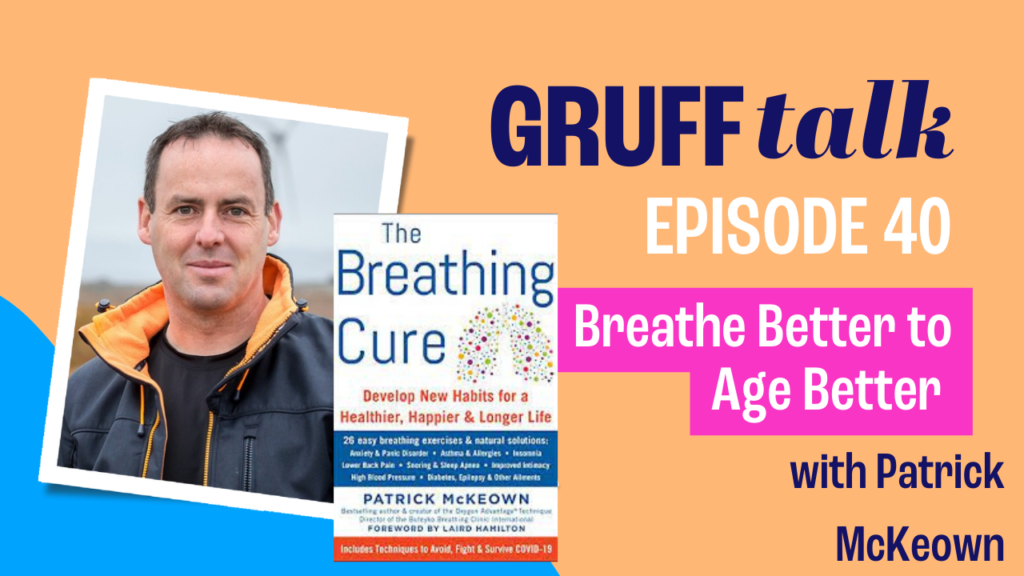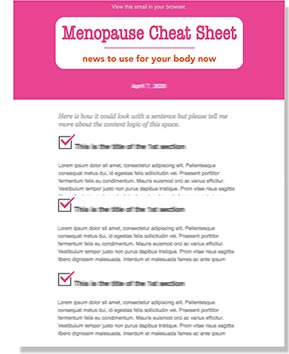LISTEN TO THIS EPISODE ABOUT THE CONNECTION BETWEEN BREATHING CORRECTLY
AND YOUR HEALTH HERE
The guest on this week’s episode of GRUFFtalk: How to Age Better is Patrick McKeown, who wrote The Breathing Cure. Patrick is an author and speaker who is known for his work on the relationship between breathing and health, particularly in the context of the Buteyko Method. The Breathing Cure is one of McKeown’s books in which he advocates for the use of controlled breathing techniques to improve overall health and well-being. In his work, McKeown emphasizes the importance of breathing through the nose and slowing down the rate of breathing to improve oxygenation, reduce stress and anxiety, and improve overall respiratory function. He argues that functional breathing practices can help to improve various health conditions, including asthma, sleep disorders, and anxiety, among others.
LISTEN TO THE EPISODE HERE
What is ‘functional breathing’ and how can it help you sleep better?
Functional breathing refers to the practice of conscious control and regulation of one’s breathing patterns. It involves controlled breathing techniques that aim to improve overall breathing efficiency, enhance physical and mental performance, and promote relaxation.
The benefits of functional breathing include reducing stress and anxiety, improving focus and concentration, increasing energy levels, and enhancing athletic performance.
Functional breathing can also help people sleep better by reducing sleep-disrupting stress levels, calming the nervous system, and promoting relaxation. Controlled breathing practices before bedtime can slow down the heart rate and decrease the levels of cortisol (a stress hormone) in the body, promoting a sense of calmness and relaxation and making it easier to fall asleep. Additionally, breathing exercises can also be used to calm racing thoughts and reduce the activity of the “fight or flight” response, both of which can interfere with sleep.
Why is it more beneficial to breathe in and out through your nose, and not through your mouth?
Breathing through the nose has several benefits compared to breathing through the mouth:
- Filtering and warming of air: The nose has tiny hairs and mucus membranes that filter and warm incoming air, helping to protect the lungs from harmful particles and irritants.
- Improved oxygenation: Nasal breathing slows down and regulates the rate of breathing, allowing for better oxygenation of the blood and tissues.
- Increased nitric oxide levels: Nitric oxide, a gas produced in the nasal passages, has been shown to have several health benefits, including improving respiratory function, boosting the immune system, and regulating blood pressure.
- Better respiratory function: Breathing through the nose requires the use of the diaphragm and other breathing muscles, which helps to strengthen respiratory function and improve overall breathing efficiency.
- Reduced stress and anxiety: Controlled nasal breathing can have a calming effect on the nervous system, reducing stress and anxiety levels.
In summary, nasal breathing has many health benefits, and it is considered a more efficient and effective way to breathe than mouth breathing. By incorporating nasal breathing into your daily routine, you can help to improve your overall respiratory health and well-being.

How can you practice functional breathing while being engaged in a vigorous workout, like running?
Functional breathing can be practiced while engaging in a vigorous workout such as running. Here are some tips to help you incorporate functional breathing into your running routine:
- Focus on slow, controlled breaths: Instead of taking short, shallow breaths, focus on taking slow, deep breaths in through your nose and out through your mouth. This will help to regulate your breathing and prevent shortness of breath.
- Time your breaths: Try to time your breaths with your steps or strides. For example, inhale for three steps and exhale for three steps. This can help to maintain a steady pace and reduce the risk of hyperventilation.
- Focus on belly breathing: Engage your diaphragm by breathing deeply into your belly, expanding your stomach on the inhale and contracting it on the exhale. This type of breathing can help to increase oxygenation and improve overall respiratory function.
- Use visual cues: Choose landmarks along your running route and breathe in as you reach them, and breathe out as you pass them. This can help to keep you focused on your breathing and prevent your mind from wandering.
Remember, it may take some time and practice to incorporate functional breathing into your workout routine, so be patient and persistent. Incorporating functional breathing can help to improve your performance, reduce fatigue, and prevent injury, leading to a more enjoyable and effective workout experience.
Learn more about functional breathing and how to do it here.
































































